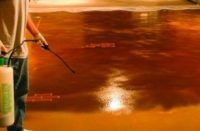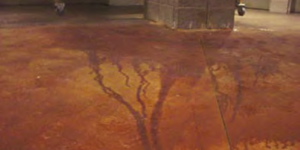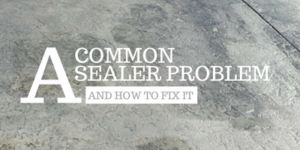Question: I have a 5-year-old stamped concrete patio that has not been resealed since being installed. The sealer is cloudy in some areas and in other areas looks like there is no sealer at all. Do I need to reseal or is there something I can do to bring back the original look and luster of the sealer? The original sealer was a solvent-based clear acrylic.

I only wish it were as easy as, “When you have a sealer issue, just apply some solvent and the problem goes away.” While there is merit to the “solvent bath” process, it is not a catchall problem-solving technique for all sealers. In fact, there are many limitations to the process, and many times the concept does not work well as a long-term fix.
The process of using a solvent bath has been around since solvent-based sealers were created. That being said, its single biggest limitation is that it only works with solvent-based sealers that dry, not cure. Any sealer that reacts with moisture or needs a catalyst or is water-based will not react favorably, or at all, when solvent is applied to its surface. This pretty much limits the solvent bath solution to solvent-based acrylic cure-and-seals and sealers.
The second limitation to the solvent bath is that it works well only when the issue is surface- or aesthetic-related, not adhesion- or substrate-related. For example, if there are blisters on the surface from applying the sealer in conditions that were too hot, or a dog walked across the sealer while it was still tacky, leaving pawprints, or some moisture got trapped in or under the sealer, a solvent bath will work well. On the flip side, a solvent bath typically does not provide long-term relief from a sealer flaking up from overapplication, or failure caused by excess stain residue or dirt, or the concrete being just too tight to allow for good adhesion.
The third limitation is that using a solvent bath will often dull the finish of the sealer. If the dull finish is not acceptable, a new thin coat of low-solids-compatible sealer may need to be applied to bring back the shine. There are also gloss-restoring products on the market that are specifically designed to bring back the shine and luster to dull and worn sealers. Consider using those products if the sealer is in good condition and your only desire is to bring back the luster and shine to the sealer.
The standard solvent bath process involves spraying store-bought xylene or acetone across the problem area. (As a side note, I do not recommend acetone, as it dries too quickly to be effective.) You wait a few minutes to allow the solvent to liquefy the sealer, then wipe or roll the area to eliminate the problem.
It should also be noted that some manufacturers have developed special products specifically designed for solvent bath applications. These products are proprietary blends of solvents that work the same as xylene but dry slower and allow for a longer working time.
In the case of the 5-year-old stamped patio, my recommendation would be to try a solvent bath with xylene or use one of the new solvent bath products on the market.
Spray a thin coat across the surface and let it liquefy the sealer. Use a clean 3/8-inch-nap roller and back-roll across the area a few times to work out the problem area. Let the area dry, and reseal as necessary to achieve the desired level of gloss and luster.
It is highly recommended to always test any of these remedial processes in an inconspicuous place prior to completing the entire job.















